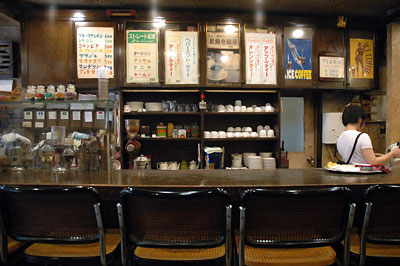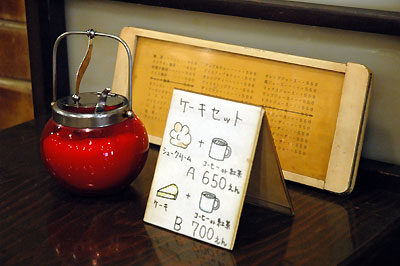Originally published in Epicure Exchange in 1997; photos taken on July 17, 2004

Unlike the dying breed of classic American coffee shops of the 1950s, the traditional coffee shop in Tokyo still thrives. These family owned coffeehouses, called kissaten (kee-sah-ten), have been around since WWII. Although most of them seem to have undergone a redecoration phase in the late sixties or early seventies, they haven’t changed much since the forties.
Walk into a kissaten on a hot summer day and you are greeted with a cheery “Irasshaimase!” from the owner’s wife, who tends the cash register and serves the coffee. Her liveliness is in contrast with her surroundings, which are dark and dank. An almost overpowering smell of mildew— the residue from years of rainy season and hot, humid summers—wafts through the room as the door closes.
The interior is dimly lit and while each shop owner decorates to his (or his wife’s) taste, dark wood and earth tones seem to predominate at most places. In this kissaten, the tables have grey marble tops, the heavy, wooden chairs have been upholstered in red velvet and the yellowing walls are strewn with clocks and landscape paintings of Europe. Lamps with hand blown globes hang at regular intervals down the corridor of tables that leads to the coffee bar.
This is not Starbucks. The coffee bar is made of wood, not laminate. It is standing height and the man who stands behind it tending the pots and grinders could never be called a barista. There is not an espresso machine in sight.

The tools of the trade look like equipment in an antique science laboratory. Arranged along the bar are a handful of gas outlets. Over each one sits a giant test tube holder with a glass bowl half full of coffee in its grip. A gas burner that would look at home in a kitchen keeps a kettle of water boiling. On a shelf behind the bar sits a group of brewing pots—a combination of glass receptacles and plastic filter baskets.
When an order is placed, the coffee man goes into action. He is fluid and artistic as he measures out and grinds an individual serving of coffee, simultaneously reaching for the brewing pot. Gently depositing the grounds into the filter basket, he carefully pours hot water into the apparatus, swirling the pot a bit to encourage the brewing, adding more water, watching until the coffee is just right. Then, selecting a cup and saucer from the mismatched collection that time has created, he removes the filter basket and pours the coffee into the cup.
His wife delivers the coffee along with a wood-topped glass container of sugar and a tiny pitcher of cream. For the price of 500 yen (about $5 US) you receive a cup of kohi (coffee), countless glasses of mizu (water) and a place to sit for as long as you like.

The emphasis in these coffeehouses is on “house” and not on coffee. The high price of coffee is as much a rental fee as it is beverage. Citizens of this crowded metropolis live in cramped quarters so alternate places to relax or work are essential. To find a kissaten that fits your mood and style is to find a second home; most kissaten boast a bevy of regular customers. Neighborhood wives take a break from daily chores and meet their friends for cafe au lait and gossip. Businessmen take refuge from the stresses of the office with a newspaper and coffee or come to vent midday frustrations with their coworkers.
The atmosphere of cool, damp, darkness keeps conversations quiet. Thoughts do not have to compete with blaring rock music and chattering schoolgirls, making the kissaten a good place to plan and work. For those in a solitary but uncontemplative mood, a shared library of used magazines and comics entertains.
When the coffee in the cup is gone, work complete, conversations finished, it is time to leave the cavern of coffee. Walking out into the hot sunshine is a pleasant shock. Across the street is an outlet of one of the coffeehouse chains. The coffee there is cheap and consistent, but the atmosphere is sterile and full of giggling girls and frantic commuters looking for a quick caffeine fix. How unenlightened.
Posted by kuri at July 19, 2004 07:51 AM